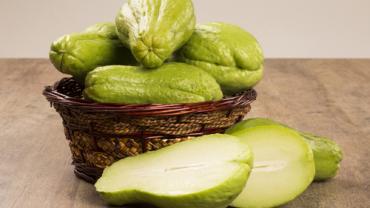
People watching their carb intake or those following an autoimmune protocol diet get pretty creative with finding acceptable substitutes for the sweet and starchy foods they may enjoy but need to avoid. There’s riced or mashed cauliflower, zucchini noodles, and cookies and cakes made with almond and coconut flour. A little-known vegetable with some not-so-little potential in this area is chayote squash. It may not be a household name, but it’s available in most well-stocked supermarkets.
Chayote squash (Sechium edule) is a gourd that belongs to the Cucurbitaceae botanical family, making it a cousin of cucumber, zucchini, pumpkin, and various melons. Chayote is native to Central America but is now consumed worldwide, especially in Latin America, Asia and the South Pacific. These fruits are bright green and somewhat pear-shaped, with a thin, edible skin and white flesh. They contain a single, large, flattened pit that is usually discarded but is safe to consume and has a nutty flavor.
Known as christophene, choko, chuchu, pear squash and many other names in various parts of the world, chayote may be eaten raw or cooked, although cooked is much more prevalent. Consumed raw, it’s typically sliced thin and added to salads, salsas, or marinated in lemon or lime juice. However it’s prepared, chayote doesn’t come to the table emptyhanded. It’s rich in vitamin C and folate, and also contains small amounts of vitamins K and B6. On the mineral side, it provides manganese and small amounts of copper and zinc.
The fruit and leaves of chayote have a potent diuretic effect. In fact, one case report attributed a state of severe hypokalemia to ingestion of chayote, with restoration of normal potassium levels after chayote was no longer consumed. Barring any abnormalities of potassium balance, consumption of a reasonable amount of chayote should not be problematic for most people. There may also be a role for chayote extract as an anti-cancer agent. Research indicates chayote extract may induce apoptosis in leukemic cell lines and inhibit proliferation of cancerous cells while leaving healthy cells unaffected.
Chayote is low in carbohydrate and high in fiber, giving it a very low glycemic load. A one-cup serving delivers 6 grams of total carbohydrate with a little over 2 grams of fiber for a net carb count of just 4 grams. Considering chayote can be boiled, mashed, baked, stuffed, or fried, it’s a welcome addition to any low-carber’s repertoire, especially if they’re ready to move on from cauliflower masquerading as potatoes.
Chaoyte fruit has a mild flavor, often described as a cross between a cucumber and a potato. This blandness makes it the perfect blank canvas to serve as a foundation for any number of Paleo, low carb, ketogenic, or AIP (autoimmune protocol) substitutes for starchy side dishes. They can be grated like potatoes and combined with carrots to make fried patties (think hash browns!), or cubed and used in a breakfast hash. For another substitute potato dish, it’s as simple as roasting chayotes with garlic and olive oil. For something on the lighter side—a palate cleanser or something to cut the richness of a heavy or fattier main dish—consider this crunchy chayote slaw/salad. And don’t forget dessert: chayote is a great stand-in for apples in gluten-free, keto-friendly pies and “apple” crumbles.
If someone’s looking to make noodles out of something other than zucchini, chayote can be spiralized and used like pasta. In fact, chayote has something in common with the popular very low carb shirataki noodles—namely, glucomannan, a polysaccharide considered to be a dietary fiber. Shirataki noodles are made from the konjac plant, because konjac is a concentrated source of glucomannan, giving the noodles a nearly negligible carb content if the fiber is subtracted. Chayote isn’t quite as low carb as konjac, but it might be a nice change of pace for some people.
By Amy Berger, MS, CNS